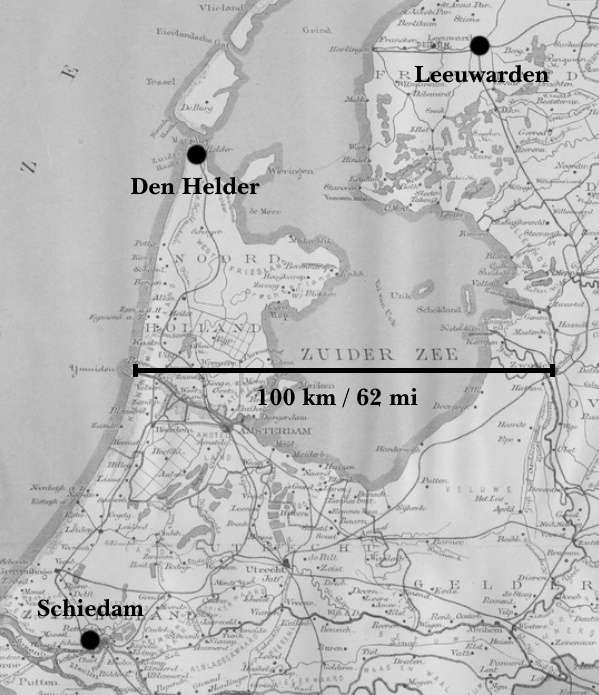A scholarly work published about the origins of the Oera Linda Book was a dissertation by Goffe Jensma.1 It presents a theory in which a triumvirate, backed by several co-conspirators, produced the manuscript in order to initially fool their intended audience and eventually — once their victims saw through the prank — make a theological statement. A basic assumption of the study was that the OLB had to be a 19th century fictional creation.
The three architects of the alleged scheme were: pastor and poet François Haverschmidt (a.k.a. Piet Paaltjens; 1835-1894),2 his friend the librarian and linguist Eelco Verwijs (1830-1880), and royal navy shipyard superintendent Cornelis Over de Linden (1811-1874). While the first two were known to have been acquaintances, Haverschmidt and Over de Linden would have had to get to know one another well enough in the 1.5 years (December 1862 to July 1864) that the former was one of three pastors at Den Helder, a parish of 9,300 members. Over de Linden, meanwhile, was known not to be a churchgoer. He was also a generation older than the pastor, was a grandfather and remarried as a widower in May 1863. The 28 year old Haverschmidt himself was married in August 1863 and became a father one year later. Both men certainly had other things on their mind — not the least of which earning a living — than concocting a highly sophisticated (and potentially dangerous) work of ‘mystification’.
| Over de Linden, age 50-58, navy shipyard supervisor | Verwijs, age 31-39, teacher/ archivist/ linguist | Haverschmidt, age 27-35, parson/ poet | |
|---|---|---|---|
| 1861 | 31 December: first wife Trijntje dies | 14 September: fiancée Aemilia dies | |
| 1862 | start as archivist-librarian | move from Foudgum (Frl.) to Den Helder in December | |
| 1863 | 14 May: marriage to Geertruida/ 26 April: marriage of son Leendert | publication about Saint Nicholas | 6 August: marriage to Jacoba |
| 1864 | 21 January: marriage to Lamberdina | move to Schiedam in July/ 13 August: birth of daughter Margot | |
| 1865 | 18 April: marriage of daughter Hendrika | publication about Germanic words for ‘woman’ | |
| 1866 | 24 December: marriage of daughter Anna | 3 December: birth of son Nicolaas | |
| 1867 | start correspondence with Verwijs | start research of Oera Linda codex | poetry collection published |
| 1868 | 8 August: son Cornelis dies in Dutch Indies | move from Leeuwarden (Frl.) to Leiden, start as editor of dictionary | 29 July: death of son Nicolaas |
| 1869 | 11 August: marriage of son Anton | has manuscript copied, end of OL research | 18 December: birth of son François |
Even accepting that these two could have become acquainted in Den Helder, they would have had to collaborate primarily by mail given that the pastor moved to Schiedam in 1864 and the linguist Verwijs lived in Leeuwarden — the three were thus each separated by hours of travel (see image). The most implausible of all the assumptions, however, is that the intelligent and talented Verwijs would have risked not only losing his career, but also being criminally prosecuted. After all, having examined the manuscript in 1867, he initially concluded that it was “irrefutably authentic” and “an ancestral manuscript, copied many times,”3 as well as asking the Frisian Provincial Executive for permission to negotiate a purchase from the owner and funding to have it copied and translated.4

If, as Jensma theorized, the manuscript was intended to be discovered as an obvious fake on second consideration, Verwijs’ request would have been utterly insane had he been complicit in its making. And even if the three creators had agreed to keep their teamwork a secret, would Verwijs have had reason to trust Over de Linden far enough to put his entire life’s work on the line? Especially since he could hardly have gotten to know him well — not to mention that Over de Linden, like himself, was known to be a drinker and thus could easily have spilled the beans?
What if King William III (1817-1890) had insisted on seeing the manuscript? Would he have taken offense at the anti-monarchist sentiments implicit in the work?
If it was a joke, it was a very dangerous one. As was later stated: “Some see [it] as the deceptive masterpiece of dark powers, created with the apparent goal of undermining the foundations of church and society.”5
In an 1863 publication about Germanic words for ‘woman’,6 Verwijs suggested that the name of the town Vronen was derived from ‘vroon’ meaning ‘lord/master’ (Dutch ‘heer’), while the form FOR.ÁNA (Dutch: voor-aan; in front) was used in Codex Oera Linda. Over his career, he published many essays about etymology. If he really had created the Fryas language, it should be possible to identify his signature. But no such evidence has ever been presented in the meticulous studies that attempt to prove his guilt.
- “De Gemaskerde God — François HaverSchmidt en het Oera Linda-boek” (The Masked God), 2004, defended at the Faculty of Theology at Groningen University. It has an English summary, accessible at www.academia.edu/619642.
- On the post image, Haverschmidt is depicted (sitting left) with student friends (source).
- Letters Verwijs to Over de Linden, 13 and 19 October 1867, at Tresoar Library, Leeuwarden.
- ‘Gedeputeerde Staten’, the executive branch of government of a province in the Netherlands.
- Dr. M. de Jong in his foreword of “Het Geheim van het Oera-Linda-Boek” (The Secret of the OLB), 1927.
- Title: ‘De namen der vrouw bij den Germaan’, 1863, p.14.

